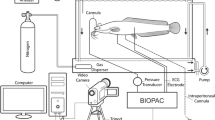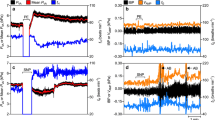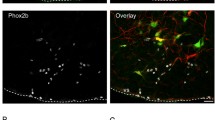Summary
The autonomic nervous and possible adrenergic humoral control of blood pressure and heart rate during hypoxia was investigated in Atlantic cod. The oxygen tension in the water was reduced to 4.0–5.3 kPa (i.e.. PwO2=30–40 mmHg), and the fish responded with an immediate increase in ventral and dorsal aortic blood pressure (P va P da), as well as a slowly developing bradycardia. The plasma concentrations of circulating catecholamines increased during hypoxia with a peak in the plasma level of noradrenaline occurring before the peak for adrenaline. Bretylium was used as a chemical tool to differentiate between neuronal and humoral adrenergic control of blood pressure and heart rate (f H) during hypoxia. The increase in P va and P da in response to hypoxia was strongly reduced in bretylium-treated cod, which suggests that adrenergic nerves are responsible for hypoxic hypertension. In addition, a small contribution by circulating catecholamines to the adrenergic tonus affecting P va during hypoxia was suggested by the decrease in P va induced by injection of the α-adrenoceptor antagonist phentolamine. The cholinergic and the adrenergic tonus affecting heart rate were estimated by injections of atropine and the β-adrenoceptor antagonist sotalol. The experiments demonstrate an increased cholicholinergic as well as adrenergic tonus on the heart during hypoxia.
Similar content being viewed by others
References
Axelsson M (1988) The importance of nervous and humoral mechanisms in the control of cardiac performance in the Atlantic cod, Gadus morhua. J Exp Biol 137:287–303
Axelsson M, Nilsson S (1986) Blood pressure control during exercise in the Atlantic cod, Gadus morhua. J Exp Biol 126:225–236
Bamford OS (1974) Oxygen reception in the rainbow trout, Salmo gairdneri. Comp Biochem Physiol 48A:69–76
Berschick CR, Bridges CR, Grieshaber MK (1987) The influence of hyperoxia, hypoxia and temperature on the respiratory physiology of the intertidal rockpool fish Gobius cobitis pallas. J Exp Biol 130:369–387
Booth JH (1978) The distribution of blood in the gills of fish: Application of a new technique to rainbow trout (Salmo gairdneri). J Exp Biol 73:119–129
Booth JH (1979a) The effects of oxygen supply, epinephrine, and acetylcholine on the distribution of blood flow in trout gills. J Exp Biol 83:31–39
Booth JH (1979b) Circulation in trout gills: The relationship between branchial perfusion and the width of the lamellar blood space. Can J Zool 57:2183–2185
Butler PJ, Axelsson M, Ehrenström F, Metcalfe JD, Nilsson S (1989) Circulating catecholamines and swimming performance in the Atlantic cod, Gadus morhua. J Exp Biol 141:377–387
Daxboeck C, Holeton GF (1978) Oxygen receptors in the rainbow trout, Salmo gairdneri. Can J Zool 56:1254–1259
Farrell AP, Sobin SS, Randall DJ, Crosby S (1980) Intralamellar blood flow patterns in fish gills. Am J Physiol 239:R428-R436
Folkow B, Neil E (1971) Circulation. Oxford University Press, Oxford
Fritsche R (1990) Effects of hypoxia on blood pressure and heart rate in three marine teleosts. Fish Physiol Biochem, 8:85–92
Fritsche R, Nilsson S (1989) Cardiovascular responses to hypoxia in the Atlantic cod, Gadus morhua. Exp Biol 48:153–160
Gehrke PC, Fielder DR (1988) Effects of temperature and dissolved oxygen on heart rate, ventilation rate and oxygen consumption of spangled perch, Leioptherapon unicolor. J Comp Physiol 157:771–782
Hallman H, Farnebo L-O, Hamberger B, Johnson G (1978) A sensitive method for the determination of plasma catecholamines using liquid chromatography with electrochemical detection. Life sciences 23:1049–1052
Helgason SSt, Nilsson S (1974) Drug effects on pre- and post-branchial blood pressure and heart rate in a free-swimming marine teleost, Gadus morhua. Acta Physiol Scand 88:533–540
Holeton GF, Randall DJ (1967) Changes in blood pressure in the rainbow trout during hypoxia. J Exp Biol 40:297–305
Holm S (1979) A simple sequentially rejective multiple test procedure. Scand J Statist 6:65–70
Hughes GM (1972) Morphometrics of fish gills. Respir Physiol 14:1–25
Keller R, Oke A, Mefford I, Adams RN (1976) Liquid chromatographic analysis of catecholamines routine assay for regional brain mapping. Life sciences 19:995–1004
Pettersson K, Nilsson S (1979) Nervous control of the branchial vasculature resistance of the Atlantic cod, Gadus morhua. J Comp Physiol 129:179–183
Pettersson K, Nilsson S (1980) Drug induced changes in cardiovascular parameters in the Atlantic cod, Gadus morhua. J Comp Physiol 137:131–138
Pettersson K, Johansen K (1982) Hypoxic vasoconstriction and the effects of adrenaline on gas exchange efficiency in fish gills. J Exp Biol 27:263–272
Randall DJ, Shelton G (1963) The effect of changes in environmental gas concentrations on the breathing and heart rate of a teleost fish. Comp Biochem Physiol 9:229–239
Saunders RL, Sutterlin AM (1971) Cardiac and respiratory responses to hypoxia in the sea raven, Hemitripterus americanus, and an investigation of possible control mechanisms. J Fish Res Bd Canada 28:491–503
Smith FM, Jones DR (1978) Localization of receptors causing bradycardia in trout (Salmo gairdneri). Can J Zool 56:1260–1265
Smith DG, Nilsson S, Wahlqvist I, Eriksson B-M (1985) Nervous control of the blood pressure in the Atlantic cod, Gadus morhua. J Exp Biol 117:335–347
Soivio A, Tuurala H (1981) Structural and circulatory responses to hypoxia in the secondary lamellae of Salmo gairdneri gills at two temperatures. J Comp Physiol 145:37–43
Taylor EW, Short S, Butler PJ (1977) The role of the cardiac vagus in the response of the dogfish Scyliorhinus canicula to hypoxia. J Exp Biol 70:57–75
Tetens V, Christensen NJ (1987) Beta-adrenergic control of blood oxygen affinity in acutely hypoxia-exposed rainbow trout. J Comp Physiol 157:667–675
Wahlqvist I, Campbell G (1988) Autonomic influences on heart rate and blood pressure in the toad, Bufo marinus, at rest and during exercise. J Exp Biol 134:377–396
Wood CM, Shelton G (1980) The reflex control of heart rate and cardiac output in the rainbow trout: interactive influences of hypoxia, haemmorhage, and systemic vasomotor tone. J Exp Biol 87:271–284
Author information
Authors and Affiliations
Rights and permissions
About this article
Cite this article
Fritsche, R., Nilsson, S. Autonomic nervous control of blood pressure and heart rate during hypoxia in the cod, Gadus morhua . J Comp Physiol B 160, 287–292 (1990). https://doi.org/10.1007/BF00302594
Accepted:
Issue Date:
DOI: https://doi.org/10.1007/BF00302594




